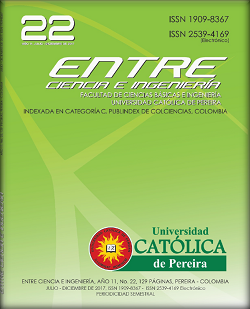ChildProgramming-C: as an improvement of the collaborative dimension of the ChildProgramming model
DOI:
https://doi.org/10.31908/19098367.3551Keywords:
ChildProgramming, Collaboration Engineering, programming for children, collaborative workAbstract
In order to design reusable processes by structuring and designing activities for teams of people through Collaboration Engineering, the Research and Development Group in Software Engineering (IDIS) of the University of Cauca, has proposed the model ChildProgramming-C, which seeks to make a contribution from the Collaborative Engineering approach to the ChildProgramming Software development model. In the progress of the investigation two exploratory case studies have been carried out with children of an Educational institution, where it was evidenced that in spite of theoretically proposing collaborative activities for children to learn to develop software, during practice there are situations that do not guarantee positive interdependence, individual responsibility and equal participation, as fundamental characteristics of collaborative work. Therefore, a preliminary phase is proposed to the Childprogramming model, which seeks to sensitize children about the importance of collaboration by being part of a team, through ludic strategies, allowing the development of social, cognitive and computational thinking skills. This article shows the experience of the sensitization phase and the evaluation through the application of a confi rmatory case study.
Downloads
References
J. Voogt, P. Fisser, J. Good, P. Mishra, and A. Yadav, “Computational thinking in compulsory education: Towards an agenda for research and practice,” Educ. Inf. Technol., vol. 20, no. 4, pp. 715–728, 2015.
J. Hurtado, C. Collazos, S. Cruz, and O. Rojas, “Child Programming: Una Estrategia de Aprendizaje y Construcción de Software Basada en la Lúdica, la Colaboración y la Agilidad,” Rev. Univ. RUTIC, vol. 1, pp. 9–14, 2012.
A. Martínez, R, D. Gasset, “Tecnología y aprendizaje colaborativo en el diseño de materiales para desarrollo del pensamiento abstracto en didáctica de las matemáticas,” RevLatinoamericana de Tecnología Educativa-RELATEC, 2007, vol. 3, no 1, p. 233-250. pp. 233–250, 2015.
J. Hurtado, C. Collazos, “Analyzing and Evaluating Collaborative Processes using Case Studies in the Software Development Context,” Proc. XV Int. Conf. Hum. Comput. Interact., pp. 1–2, 2014.
C. Collazos, L. Guerrero, J. A. Pino, S. Renzi, J. Klobas, M. Ortega, M. A. Redondo, and C. Bravo, “Evaluating collaborative learning processes using system-based measurement,” Educational Technology and Society, vol. 10, no. 3. pp. 257–274, 2007.
J. L. Jurado and C. A. Collazos, “La mejora de procesos en la gestión de proyectos , una perspectiva desde la Ingeniería de la Colaboración,” Ingenium, vol. 7, no. 15, pp. 51–59, 2013.
R. O. Briggs, A. P. Massey, and G.-J. de Vreede, “Collaboration Engineering : Foundations and Opportunities : Editorial to the Special Issue on the Journal of the Association of Information Systems Journal of the Association for Information Systems Collaboration Engineering : Foundations and Opportunitie,” no. March 2016, 2009.
G.-J. De Vreede and R. O. Briggs, “Collaboration Engineering: Designing Repeatable Processes for High-Value Collaborative Tasks,” Proc. 38th Annu. Hawaii Int. Conf. Syst. Sci., vol. 0, no. C, p. 17, 2005.
G. L. Kolfschoten, R. O. Briggs, G. J. de Vreede, P. H. M. Jacobs, and J. H. Appelman, “A conceptual foundation of the thinkLet concept for Collaboration Engineering,” Int. J. Hum. Comput. Stud., vol. 64, no. 7, pp. 611–621, 2006.
G. L. Kolfschoten and G.-J. de Vreede, “The collaboration engineering approach for designing collaboration processes,” in Groupware: Design, Implementation, and Use, Proceedings, vol. 4715, 2007, pp. 95–110.
G.-J. de Vreede, R. O. Briggs, and A. P. Massey, “Collaboration Engineering: Foundations and Opportunities,” J. Assoc., vol. 10, pp. 121–137, 2009.
D. W. Johnson, R. T. Johnson, “Learning together and alone,” vol. Prentice H. 1994.
“E. Turban, “Management Support System, Decision Support and Expert System,” New Jersey, Prentice Hall, 1995, pp. 10-127.,” p. 1995, 1995.
P. Mendoza, P. Galvis, “Juegos Multiplayer: Juegos Colaborativos Para La Educación,” Informática Educ., vol. 11, no. 2, pp. 223–239, 1998.
C. Collazos, J. Mendoza, “How to take advantage of ‘cooperative learning’ in the classroom.” Educación y Educadores, 2006, vol. 9, no 2, p. 61-76.
K. Sheingold, R. Pea, “Mirrors of Minds: Patterns of Experience in Educational Computing”, Ablex Publishing Corporation, 355 Chestnut Street, Norwood, NJ 07648, 1987.
S. T. Cruz, O. E. Rojas, J. Alegría“Un Modelo Para la Enseñanza de la Programación de Software en niños a través de Estrategias Colaborativas,” Universidad del Cauca, 2013.
H. Orejuela, A. García, J. Alegria, and C.Collazos, “Analizando y Aplicando la Gamificación en el Proceso ChildProgramming,” Rev. Colomb. Comput. - RCC, vol. 14, no. 2, pp. 7–23, 2014..
P. Runeson, M. Höst, “Guidelines for conducting and reporting case study research in software engineering,” Empir. Softw. Eng., 2009.
J. Archer-Kath, D. W. Johnson, R. T. Johnson, “Individual versus Group Feedback in Cooperative Groups,” The Journal of Social Psychology, vol. 134. pp. 681–694, 1994.
E. Severin, “Educación y Desarrollo Post-2015,” Apuntes, no. 3, pp. 1–18, 2014.
M. S. Aronson, N. Blaney, C. Stephan, J. Sikes, “The Jigsaw Classroom Aronson” . Sage, 1978.
C. Collazos, J. Muñoz, and Y. Hernández, “Aprendizaje Colaborativo Apoyado por Computador,” J. Chem. Inf. Model., p. 66, 2014.
C. Collazos, “How to take advantage of ‘ cooperative learning ’ in the classroom,” Educ. y Educ., vol. Volumen 9, no. 4128, pp. 61–76, 2006.
J. George, L. Gan, and B. Jessica, “Learning cooperative learning via cooperative learning,” Hawker Brownlow Education Learning, 2007.
A. M. Pallarés, “Técnicas de grupo para educadores”. Publicaciones ICCE, 1982.
G. Kolfschoten and G.-J. Vreede, “The Collaboration Engineering Approach for Designing,” in Groupware: Design, Implementation, and Use, vol. 4715, 2007, pp. 95–110.






 Revista Entre Ciencia e Ingeniería
Revista Entre Ciencia e Ingeniería .png) entrecei@ucp.edu.co
entrecei@ucp.edu.co.png) ISSN (Impreso) 1909-8367 - ISSN (En Línea) 2539-4169
ISSN (Impreso) 1909-8367 - ISSN (En Línea) 2539-4169 Attribution-NonCommercial 4.0 International (CC By-NC 4.0)
Attribution-NonCommercial 4.0 International (CC By-NC 4.0)
.png) Carrera 21 No. 49-95 Av. de las Américas, Pereira, Risaralda, Colombia
Carrera 21 No. 49-95 Av. de las Américas, Pereira, Risaralda, Colombia